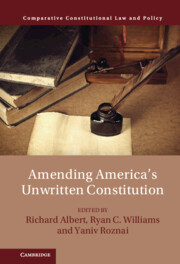Book contents
- Amending America’s Unwritten Constitution
- Comparative Constitutional Law and Policy
- Amending America’s Unwritten Constitution
- Copyright page
- Contents
- Contributors
- Acknowledgments
- Introduction A Return to Constitutional Basics: Amendment, Constitution, and Writtenness
- 1 The Unwritten Constitutions of the United States
- 2 Enumerating Amendments
- 3 Change Is the Only Constant: Unwritten Amendments and the Courts
- 4 The Role of the People in Unwritten Amendments
- 5 Unwritten State Constitutions? In Search of Constitutional Communities
- 6 State Constitutions and the Interaction between Formal Amendment and Unwritten Commitments
- 7 The Drive for a National Popular Vote for the Presidency: A Case Study in Amending the Unwritten Constitution
- 8 The Trump Presidency, the Racial Realignment, and the Future of Constitutional Norms
- 9 Amending an Unwritten Constitution: Comparative Perspectives
- 10 The Unwritten Foundations of (All) Written Constitutions
- Index
2 - Enumerating Amendments
Published online by Cambridge University Press: 13 October 2022
- Amending America’s Unwritten Constitution
- Comparative Constitutional Law and Policy
- Amending America’s Unwritten Constitution
- Copyright page
- Contents
- Contributors
- Acknowledgments
- Introduction A Return to Constitutional Basics: Amendment, Constitution, and Writtenness
- 1 The Unwritten Constitutions of the United States
- 2 Enumerating Amendments
- 3 Change Is the Only Constant: Unwritten Amendments and the Courts
- 4 The Role of the People in Unwritten Amendments
- 5 Unwritten State Constitutions? In Search of Constitutional Communities
- 6 State Constitutions and the Interaction between Formal Amendment and Unwritten Commitments
- 7 The Drive for a National Popular Vote for the Presidency: A Case Study in Amending the Unwritten Constitution
- 8 The Trump Presidency, the Racial Realignment, and the Future of Constitutional Norms
- 9 Amending an Unwritten Constitution: Comparative Perspectives
- 10 The Unwritten Foundations of (All) Written Constitutions
- Index
Summary
In this chapter, Sanford Levinson examines the practice and implication of appending amendments to the end of the Constitution and inquires how many times the Constitution has amended. The presumptively correct answer number of amendments, at present, is twenty-seven, but those are only textual amendments to the Constitution. “How many times has the United States Constitution been amended” generates what Wittgenstein well described as “mental cramps.” His own belief was that one could cure these cramps by dissolving many traditional questions of philosophy. We could do the same if we adopted a truly minimalist understanding of “constitutionalism” that allowed, for example, anyone designated as the Ruler to rule by absolute discretion. One might proffer this as a variant of Hobbesian constitutionalism, whereby the sovereign people, realizing that nothing else can in fact guarantee them the security they yearn for, delegate their powers to an all-powerful Leviathan. An alternative is what has come to be identified as “liberal constitutionalism,” with the attached meaning of governments that are established through institutions created (and limited) by the constitution itself.
Keywords
- Type
- Chapter
- Information
- Amending America's Unwritten Constitution , pp. 57 - 72Publisher: Cambridge University PressPrint publication year: 2022



